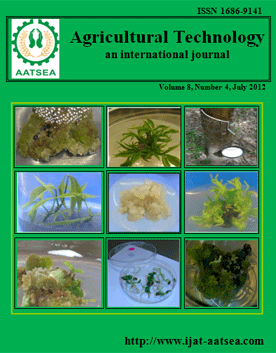ThaiScience
ThaiScience
INTERNATIONAL JOURNAL OF AGRICULTURAL TECHNOLOGY
Volume 18, No. 01, Month JANUARY, Year 2022, Pages 1 - 12
The efficacy of cinnamomum parthenoxylon roots as a biopesticide towards termite and wood-rotting fungi.
Adfa, M., Utomo, B., Oktavia, L., Yudha, S. S., Banon, C., Gustian, I. and Maryanti, E.
Abstract Download PDF
The antitermite and antifungal activity of C. parthenoxylon roots constituents, namely n-hexane and methanol fractions against termite (Coptotermes curvignathus) and wood-rotting fungi (Trametes versicolor) was determined. The results showed that both fractions at 15% concentrations were reduced the survival of termite to 100% after 7 and 6 days of treatment. In addition, both fractions exhibited significant inhibition effects towards fungal growth compared to the control. The data showed that n-hexane fraction was more toxic than methanol fraction against T. versicolor. At 0.25% concentration, n-hexane and methanol fractions inhibited the fungal growth to 100% and 78.33%, respectively. The GC-MS profiling showed that most of the compounds detected from both fractions consisted of phenylpropanoid, aldehyde, fatty acids, long-chain hydrocarbons, sesquiterpenes, and lignans. The major component of n-hexane fraction were safrol (46.8%), octadecanal (14.35%), and elemicin (9.55%). While the main compounds of methanol fraction included 9,12-octadecadienoic acid, methyl ester (8.29%), safrole (7.98%), and octadecanoic acid, methyl ester (7.01%). The preliminary phytochemical test showed that n-hexane fraction contains terpenoids and coumarins, while the methanol fraction contains flavonoids, saponins, and tannins. Therefore, the presence of these compounds might be responsible for their antitermite and antifungal activities. It was observed that the antitermite potential of C. parthenoxy
Keywords
Cinnamomum parthenoxylon, Fungicidal, GC-MS, Safrole, Termiticidal activityINTERNATIONAL JOURNAL OF AGRICULTURAL TECHNOLOGY
Published by : Association of Agricultural Technology in Southeast Asia (AATSEA)
Contributions welcome at : http://www.ijat-aatsea.com
